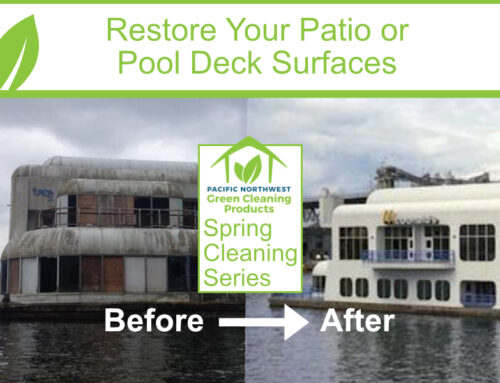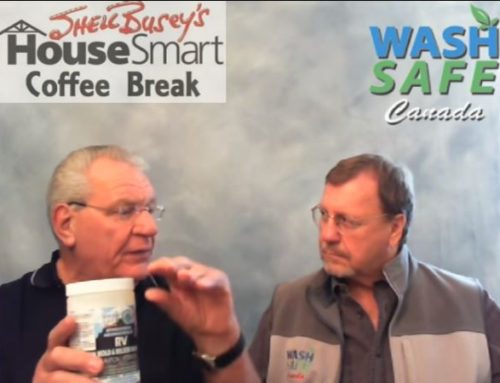There are 3 options when it comes to removing roof moss.
Which method is right for you? Well that all depends on your skill level, the equipment available and the height and pitch of your roof.
Before we get to the moss removal methods, these methods all have two things in common (1) these methods have only proved to be successful using Wash Safe’s Tile Roof Wash or Roof Wash(2) in all 3 methods you will need to spray the roof cleaner up on to the roof, there are different methods of accomplishing this, please read the article “applying cleaner to roofs and siding” for detailed directions.
The Gradual Method: The Gradual Method: The gradual roof moss removal method is actually pretty easy to do and simple to explain. Just coat your roof with the roof cleaner and let Mother Nature do the rinsing for you. Does it sound too good to be true? Well it isn’t, it does have some negative aspects that I’ll explain but it definitely works, we guarantee it. The first aspect that people don’t really like about it is that it takes time to see the final result, there is no instant gratification. Once the roof cleaning solution has been applied you will notice over the next few days that the moss has changed in color from green to brown, then as a few weeks go by you will notice that the, now brown moss has become very dry and brittle and has even shrunk in size. At this point the moss will begin to detach from the roof and you will notice pieces of moss on the ground or in the gutters. Over the next couple of months with the help of the rain, wind, sun, snow and ice the moss will begin to disappear and you will be able to see you roof again. Some extreme cases may require another application to remove any of the remaining stubborn moss colonies. A yearly coating of our roof cleaner makes a great maintenance plan to assure that the moss will not return. On the positive side, the gradual method only takes 20 minutes to spray the solution on the roof and you do not have to climb up on a dangerous roof. So, if you have a steep roof or no desire to climb up on your roof, no time to physically clean your roof and don’t mind waiting about 90 days, then this method is for you. Unlike toxic roof moss cleaning agents like zinc sulfate that can have extreme negative effects around your home our hydrogen peroxide mix which comes in a powdered form, when mixed with water is only active as a cleaner for 4-6 hours before biodegrading. It is by far the most effective moss cleaner that can make eco-safe claims.
The Brush and Hose Method: This roof cleaning method is for somebody who doesn’t mind a little physical work, for someone who doesn’t own a pressure washer and for someone who has no fear about going up on to the roof. It’s pretty self explanatory, spray the roof cleaning product on, brush and hose off. There are a few roof cleaning tips to this method that I will explain. (1)The moss will come off easier if you have the proper brush we recommend, (2) the moss will definitely come off the same day but it will come off easier if you presoak the affected area 7 days before, (3) always brush the moss while it is wet with product this will significantly reduce the possibilities of damaging the shingle, (4) only spray an area you can clean before it the product dries, if it happens to dry just reapply some product. So it’s pretty simple, spray the roof cleaner on to an affected area that you can clean before it dries, usually 10’x10’ areas work well, spray the product on, let it work for 10-15 minutes, re-wet if you have to, then brush, circular motions work best. Once the roof moss is unattached, rinse the area thoroughly with water.
The Power Washing Method: If you have the equipment and are capable of getting up and working on your roof then this is the best method to remove roof moss. This method begins by coating the entire moss affected area of the roof with our Roof Wash; let the product go to work on the roots of the moss for at least 15-20 minutes before starting to clean the roof, it is ok if the product dries in this method because the water will reactivate the cleaning product when you rinse it with the pressure washer. Another reason that it is ok to let dry is because wet moss is as slippery as ice, you have much better footing when it dries but you should always take safety precautions and put some kind of roof staging up on steep pitched roofs or use a safety harness. After the roof has been coated and dried it’s time to start washing the moss off. Pressure washing a roof has a gotten a bad rap over the years, for the most part due to a few inexperienced pressure washers but equal to that is the cleaning product used. Our roof cleaner weakens the roots so much that a very light pressure is all that is needed to remove the moss. Without our product some pressure washers would basically dig the moss off of the roof, taking with it a good portion of the shingle. We recommend using as little pressure as possible, if you can’t put your hand under the pressure then you are using too much. When using a pressure washer on a roof never spray up the roof or to the side this is how shingles get blown off, always start from the top and aim down the roof so that the pressure is just glancing off of the roof, this angle allows the water to get under the weakened moss, just like a spatula flipping an egg in a pan and the moss will slide right off without any damage to the roof shingles. Again, the key to this is the cleaning product that allows the roots to be removed with the moss, most other products or just straight water will only take the top of the flower off, leaving the roots behind, still eating and will soon bloom again.
All three of the above mentioned roof cleaning methods will effectively clean and save your roof from damaging forms of roof fungus, the method you choose will obviously depend on experience and equipment available. In the end the most importantly you can expect, by cleaning your roof, to extend the life and improve the look of your roofing material.



